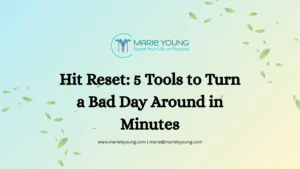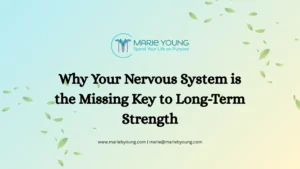Stress is just something we all have to face these days–and it really sucks! Whether you’re a student pulling all-nighters, hustling with your side gig or grinding away at the office, stress is like our daily companion that rides with us everywhere.
So what’s the solution? Yoga? Meditation? Sure, those things do help, but they’re kind of hard to do on your own. Attending classes or watching a 30-minute YouTube video? Ain’t nobody got time for that! If we did, we sure as hell wouldn’t be stressed out all the time. And let’s face it, not all of us are flexible and fit for something like yoga, and some people find it hard to sit still for long enough to make meditation work.
But that’s where Body-Informed Resiliency (BIR) comes in handy.
Okay, sure, it sounds like a funky therapy thing that some distant relative tries to sell you on–but it’s actually a lot simpler than you’d expect. Think of it like mixing together yoga and meditation, but simplifying it so that we can get those benefits in a much shorter time and without needing to attend long in-person classes.
Perhaps one of the best things about BIR is how everyone can do it. Don’t think you’re flexible enough for yoga? No problem! Have an injury that makes it tough to work out? No worries! BIR techniques are doable by anyone and everyone. You can even do them just sitting in your chair–how handy is that? You have no excuse not to try it!
So let’s dive deeper into the topic of BRI to get a better understanding of what it’s all about.
The Basics of Body-Informed Resiliency
Whether you like it or not, your body is always looking out for you like a trusty sidekick, ready to swoop in and rescue you when stress comes knocking.
One of the many superpowers we have is called the Autonomic Nervous System (ANS). Think of it like a crack team of engineers that work night and day to keep your body running smoothly even when the lights are out. They help to regulate basic bodily functions such as our heart beating or breathing, and they’re constantly working to keep our body in good condition.
But if your body’s maintenance crew is looking after you, then who or what looks after them? That’s where BIR comes in!
Understanding Our Autonomic Nervous System
There are two main things about the ANS that are important to BIR:
- The sympathetic nervous system prepares our body to react when we’re stressed. It’s known as a “fight or flight” response.
- The parasympathetic nervous system is the opposite, helping us relax with processes known as “rest and digest” responses.
These two systems are like a tag team duo, working hard to maintain a healthy balance in our system. They prepare us for stressful situations and they also help us rest and relax afterwards.
This balance is controlled by the vagus nerve, a cranial nerve that extends from our brainstem down through the neck and into other organs like our heart, lungs, and digestive tract. You can think of it like a conductor waving their baton around, controlling the individual instruments in an orchestra.
Learning To Activate the Vagus Nerve
By understanding and working with our body’s internal conductor, we can create a relaxation response and a sensation of physiological safety in the body. This basically means that we can learn to manually trigger parasympathetic responses to encourage the “rest and digest” systems of our body, thus reducing stress and promoting relaxation. Think of it like learning to relax on demand!
BIR focuses on engaging the ventral vagal complex to induce parasympathetic responses. In other words, BIR techniques and practices can help our bodies by slowing things down and putting us into repair mode.
Summary of Body-Informed Resiliency
In short, BIR is all about understanding and activating the ventral branch of the vagus nerve to help us relax.
Techniques and Practices Used in Body-Informed Resiliency
BIR uses several techniques and practices to form a connection between your body and mind. The purpose of these techniques is to help activate the ventral branch of the vagus nerve to help you relax and feel safe.
BIR is designed to be inclusive so that everyone can use it. The techniques and practices are both straightforward and accessible because they can be done by virtually anyone! These techniques include:
Shaking It Out
A simple full-body shake that moves energy around your body to get the blood circulating. Yes, this literally means to just get up and shake your body around! It can be done anywhere and only requires that you stand up. This is a technique that people use in physical therapy and yoga as a way to combat stress.
It works because shaking your body releases tension in the muscles which is often seen as a sign of stress. By reducing stress like this, it tells the rest of your body to slow down sympathetic responses and replace them with parasympathetic responses to help your body relax.
So yes, getting up and shaking your body around is good for you!
Diaphragmatic Breathing
This next exercise involves deep and slow breathing to contract the diaphragm when inhaling, and then relaxing when you exhale. Deep breathing allows the lung to expand, stimulating the vagus nerve because it’s connected to the respiratory system. Movements in the diaphragm also gently massage the vagus nerve to provide further stimulation, thus triggering increased parasympathetic activity.
The result is reduced production of stress hormones such as cortisol, and shifting an individual’s focus away from stressors to achieve a mindful state. When combined, your body will reduce sympathetic nervous system activity and introduce the calming effects of the parasympathetic nervous system.
But to keep things simple: slow and controlled breathing will help relax your body and ease your worries.
Face Work
Facial, neck, and skull massages that focus on scalenes, sternocleidomastoid muscle (SCM), TMJ, cheekbones, temples, the skull and more. This is caused by direct mechanical stimulation of the vagus nerve’s branches which can encourage ventral activity and leads to an increase in parasympathetic nervous system activity and promotes relaxation while reducing stress.
In other words, moving your face around reduces stress and improves blood flow! You can encourage this more by massaging areas around the neck and head. This supports the vagus nerve by ensuring better oxygen and nutrient delivery to the nerve cells while also removing metabolic waste products.
Other kinds of face work involve eye movements and mouth movements. Eye movements can stimulate the vagus nerve to induce relaxation, and they also help to reduce cortisol levels while raising mindfulness and distracting individuals from stressors.
Mouth movements add a bit of humor to BIR because they’re a fun and unique way to induce parasympathetic responses in the body. This can involve stretching the lips, extending the tongue, blowing raspberries, and flicking the tongue on the tip of the mouth. Other mouth movements such as humming, singing, and facial exercises can also trigger positive feelings.
Trunk Work
Trunk work usually involves seated movements of the spine and moving your shoulders in a circular motion. These exercises are simple and can be done from the comfort of your chair, and they can have a positive impact on your stress management by inducing parasympathetic responses
Trunk work can also affect the movement of cerebrospinal fluid (CSF) through the central nervous system. This helps with removing metabolic waste from the brain, makes it easier to transport nutrients to the brain, and improves our cognitive performance.
OM Chanting
OM chanting is a traditional practice that is usually associated with yoga and meditation. It has deep roots in spiritualism and religion, and is considered a sacred sound by many around the world. Try to picture people sitting with their legs crossed meditating humming the “om” sound–that’s basically what it is.
Chanting OM helps to stimulate the parasympathetic system due to a number of interconnected mechanisms. Firstly, there’s the physical act of chanting and the associated rhythmic breathing which stimulates the vagus nerve. Secondly, deep breathing through OM chanting encourages full oxygen exchange, which is known to have a positive effect on heart rate and blood pressure. Lastly, the act of chanting creates physical vibrations in the throat and chest, leading to direct mechanical stimulation of the vagus nerve due to its close proximity to the vocal cords.
Who Can Benefit From Body-Informed Resiliency?
BIR provides fantastic benefits to a wide range of individuals who may be facing unique challenges that lead to stress. The practices and techniques involved are designed to be inclusive as well, meaning that anyone can take part regardless of things like time commitment, physical strength, and well-being.
Here are some examples of people who can benefit from BIR:
- Individuals who are facing chronic stress or anxiety.
- People facing PTSD or trauma who need tools to process their trauma safely.
- Professionals who work in stressful environments.
- Athletes looking to enhance performance and speed up recovery processes.
- Students facing academic pressures.
- Elderly or less mobile individuals who struggle with other stress management practices.
- Parents and individuals with high-responsibility roles/
This isn’t a full list of people that can benefit from BIR. If you’re facing any kind of stress management difficulties in life, then the practices and techniques involved in BIR can be beneficial to you.
Benefits of Body-Informed Resiliency
One of the primary goals of BIR is to achieve a greater sense of peace and well-being. Achieving a state of calm leads to improved mental health, but it also has tangible effects on the body as well.
- Improved emotional regulation to facilitate better control over your emotions. This results in lowered stress and anxiety levels.
- Increased mental resilience means being able to bounce back quickly from life’s toughest challenges and stressful situations.
- An enhanced sense of peace and well-being leads to contentment in daily life.
- Effective stress management skills will develop, leading to more effective methods of navigating and recovering from stress.
- Physiological health benefits such as lower blood pressure and improved heart rate variability.
- Strengthened body and mind connection enhances your mindfulness by making you more aware of bodily sensations and emotional states.
- Improved sleep quality promotes relaxation and assists with establishing a healthy sleeping pattern.
- Enhanced mental clarity by encouraging mindfulness.
These benefits show the power of BIR as a practice for improving your quality of life and beating the daily stress that we face.
Advantages Over Other Stress Management Techniques
BIR is one of many practices that can assist with stress management. However, it’s been developed with inclusivity and accessibility in mind, while also promoting a holistic path to wellness that differs from many traditional therapies and techniques.
By focusing on the connection between the mind and body, BIR creates a complete approach to stress management. However, it doesn’t ignore cognitive aspects and delves into the science of why our body reacts the way it does. The focus on activating the ventral branch of the vagus nerve is what the techniques and practices of BIR are designed around.
The focus on inclusivity means that anyone can utilize BIR. No matter your profession, physical fitness, or the level of stress that you face, the techniques in BIR encourage self-care and can be changed or added to existing techniques. It creates a fantastic starting point for personal growth and healing that anyone can utilize.
Adding Body-Informed Resiliency Into Your Daily Life
Adding BIR into your daily life involves making a few positive changes to your lifestyle. The techniques and practices involved are designed to be customizable and inclusive, meaning they can fit into anyone’s schedule without taking up too much time or becoming a huge investment.
Here are some examples of simple changes that can help you achieve equilibrium between your sympathetic and parasympathetic nervous systems:
- Establish a Routine: Establishing a routine means making a daily habit of mindful practices and techniques that will become a part of your everyday life.
- Listen to Your Body: Pay attention and listen closely to your body. Understand what it needs, know when to take a break, and don’t push yourself. It helps to practice quiet meditation or gentle exercises to encourage mindfulness.
- Set Reminders: Remind yourself to use a few minutes each day to engage in practices and techniques that encourage BIR.
If you add these strategies together with the techniques and practices of BIR, it’ll be much easier to achieve a healthy balance between your sympathetic and parasympathetic nervous systems.
Conclusion
Body-Informed Resiliency is a stress-reduction technique that has been refined over many years. It’s a complete approach to wellness that focuses on the relationship between the body and mind, and focuses on physiological techniques that harness the healing power of the vagus nerve.
Embracing BIR can lead to huge benefits no matter your background or lifestyle. If you’d like to learn more, don’t hesitate to check out the one-week Body-Informed Resiliency course that will offer more peace, satisfaction, and confidence, in addition to greater empowerment through self-help healing techniques.




